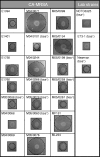Production of the Bsa lantibiotic by community-acquired Staphylococcus aureus strains
- PMID: 20023032
- PMCID: PMC2812960
- DOI: 10.1128/JB.01375-09
Production of the Bsa lantibiotic by community-acquired Staphylococcus aureus strains
Abstract
Lantibiotics are antimicrobial peptides that have been the focus of much attention in recent years with a view to clinical, veterinary, and food applications. Although many lantibiotics are produced by food-grade bacteria or bacteria generally regarded as safe, some lantibiotics are produced by pathogens and, rather than contributing to food safety and/or health, add to the virulence potential of the producing strains. Indeed, genome sequencing has revealed the presence of genes apparently encoding a lantibiotic, designated Bsa (bacteriocin of Staphylococcus aureus), among clinical isolates of S. aureus and those associated with community-acquired methicillin-resistant S. aureus (MRSA) infections in particular. Here, we establish for the first time, through a combination of reverse genetics, mass spectrometry, and mutagenesis, that these genes encode a functional lantibiotic. We also reveal that Bsa is identical to the previously identified bacteriocin staphylococcin Au-26, produced by an S. aureus strain of vaginal origin. Our examination of MRSA isolates that produce the Panton-Valentine leukocidin demonstrates that many community-acquired S. aureus strains, and representatives of ST8 and ST80 in particular, are producers of Bsa. While possession of Bsa immunity genes does not significantly enhance resistance to the related lantibiotic gallidermin, the broad antimicrobial spectrum of Bsa strongly indicates that production of this bacteriocin confers a competitive ecological advantage on community-acquired S. aureus.
Figures




Similar articles
-
Molecular characteristics of community-acquired methicillin-resistant Staphylococcus aureus in Hokkaido, northern main island of Japan: identification of sequence types 6 and 59 Panton-Valentine leucocidin-positive community-acquired methicillin-resistant Staphylococcus aureus.Microb Drug Resist. 2011 Jun;17(2):241-50. doi: 10.1089/mdr.2010.0136. Epub 2011 Mar 13. Microb Drug Resist. 2011. PMID: 21395449
-
Demography and Intercontinental Spread of the USA300 Community-Acquired Methicillin-Resistant Staphylococcus aureus Lineage.mBio. 2016 Feb 16;7(1):e02183-15. doi: 10.1128/mBio.02183-15. mBio. 2016. PMID: 26884428 Free PMC article.
-
Panton-Valentine leukocidin and staphylococcal cassette chromosome mec characterization of community acquired methicillin-resistant Staphylococcus aureus.Cent Eur J Public Health. 2019 Mar;27(1):58-63. doi: 10.21101/cejph.a4979. Cent Eur J Public Health. 2019. PMID: 30927399
-
Community-acquired necrotizing pneumonia caused by methicillin-resistant Staphylococcus aureus producing Panton-Valentine leukocidin in a Chinese teenager: case report and literature review.Int J Infect Dis. 2014 Sep;26:17-21. doi: 10.1016/j.ijid.2014.02.025. Epub 2014 Jun 26. Int J Infect Dis. 2014. PMID: 24980464 Review.
-
Lactic acid bacteria and their bacteriocins: new potential weapons in the fight against methicillin-resistant Staphylococcus aureus.Future Microbiol. 2022 Jun;17:683-699. doi: 10.2217/fmb-2021-0256. Epub 2022 Apr 13. Future Microbiol. 2022. PMID: 35414206 Review.
Cited by
-
Pseudomycoicidin, a Class II Lantibiotic from Bacillus pseudomycoides.Appl Environ Microbiol. 2015 May 15;81(10):3419-29. doi: 10.1128/AEM.00299-15. Epub 2015 Mar 13. Appl Environ Microbiol. 2015. PMID: 25769830 Free PMC article.
-
Genetic manipulation of Staphylococci-breaking through the barrier.Front Cell Infect Microbiol. 2012 Apr 12;2:49. doi: 10.3389/fcimb.2012.00049. eCollection 2012. Front Cell Infect Microbiol. 2012. PMID: 22919640 Free PMC article. Review.
-
Restoration of bioactive lantibiotic suicin from a remnant lan locus of pathogenic Streptococcus suis serotype 2.Appl Environ Microbiol. 2014 Feb;80(3):1062-71. doi: 10.1128/AEM.03213-13. Epub 2013 Nov 22. Appl Environ Microbiol. 2014. PMID: 24271178 Free PMC article.
-
Lessons learned from the transformation of natural product discovery to a genome-driven endeavor.J Ind Microbiol Biotechnol. 2014 Feb;41(2):315-31. doi: 10.1007/s10295-013-1361-8. Epub 2013 Oct 19. J Ind Microbiol Biotechnol. 2014. PMID: 24142337 Free PMC article. Review.
-
Comprehensive Approaches for the Search and Characterization of Staphylococcins.Microorganisms. 2023 May 18;11(5):1329. doi: 10.3390/microorganisms11051329. Microorganisms. 2023. PMID: 37317303 Free PMC article.
References
-
- Ambulos, N. P., Jr., T. Smith, W. Mulbry, and P. S. Lovett. 1990. CUG as a mutant start codon for cat-86 and xylE in Bacillus subtilis. Gene 94:125-128. - PubMed
-
- Augustin, J., R. Rosenstein, B. Wieland, U. Schneider, N. Schnell, G. Engelke, K. D. Entian, and F. Gotz. 1992. Genetic analysis of epidermin biosynthetic genes and epidermin-negative mutants of Staphylococcus epidermidis. Eur. J. Biochem. 204:1149-1154. - PubMed
-
- Baba, T., F. Takeuchi, M. Kuroda, H. Yuzawa, K. Aoki, A. Oguchi, Y. Nagai, N. Iwama, K. Asano, T. Naimi, H. Kuroda, L. Cui, K. Yamamoto, and K. Hiramatsu. 2002. Genome and virulence determinants of high virulence community-acquired MRSA. Lancet 359:1819-1827. - PubMed
-
- Bekal-Si Ali, S., Y. Hurtubise, M. C. Lavoie, and G. LaPointe. 2002. Diversity of Streptococcus mutans bacteriocins as confirmed by DNA analysis using specific molecular probes. Gene 283:125-131. - PubMed
Publication types
MeSH terms
Substances
LinkOut - more resources
Full Text Sources
Medical

